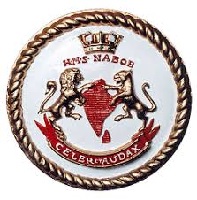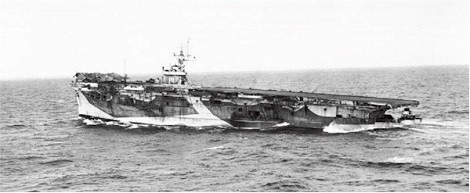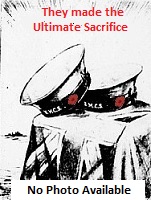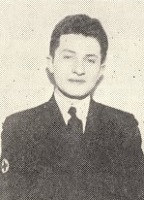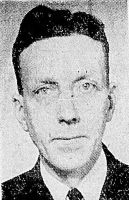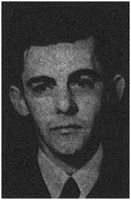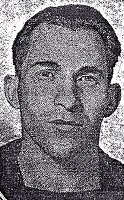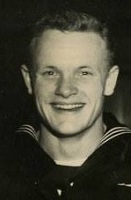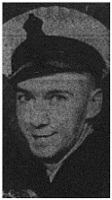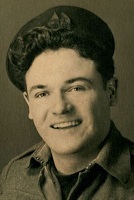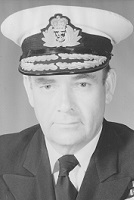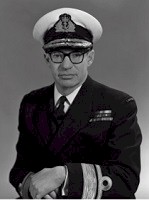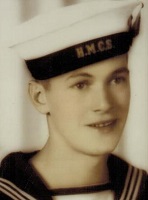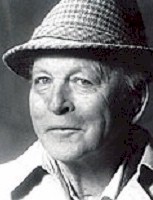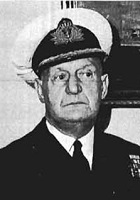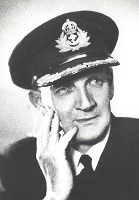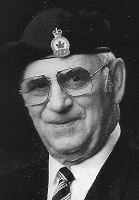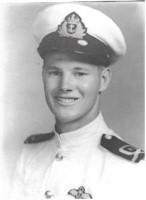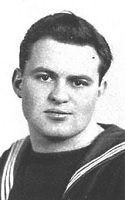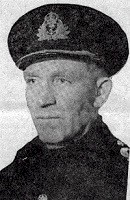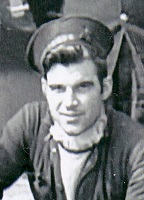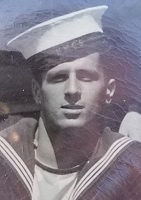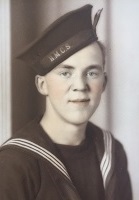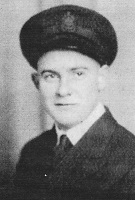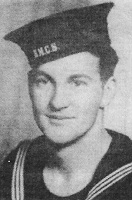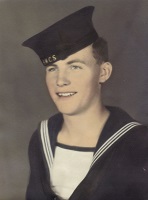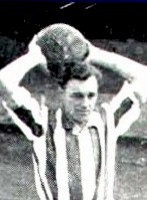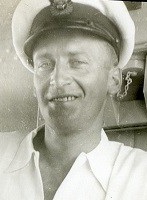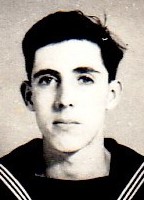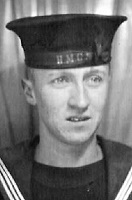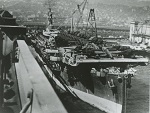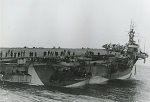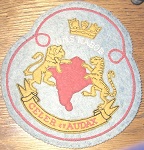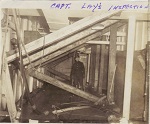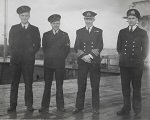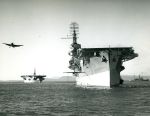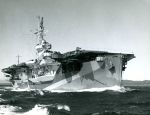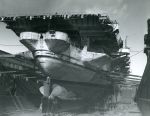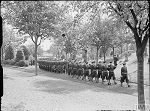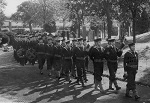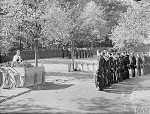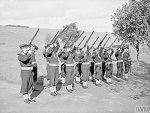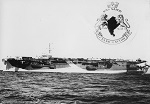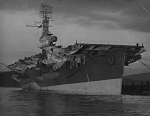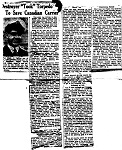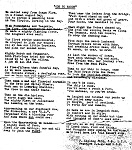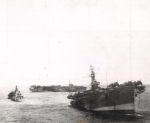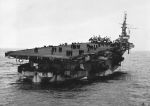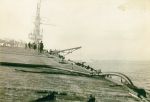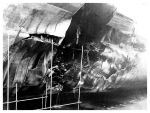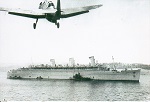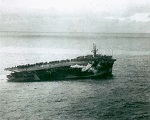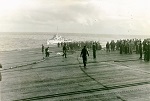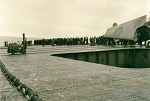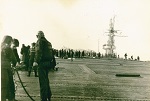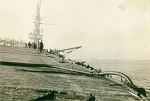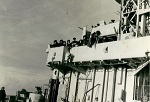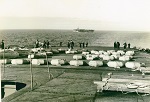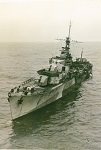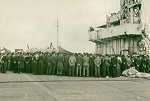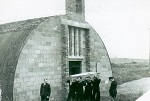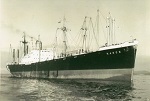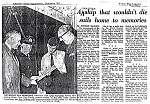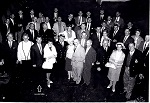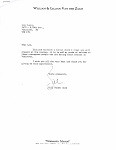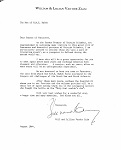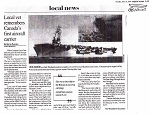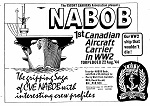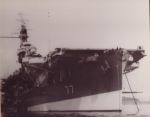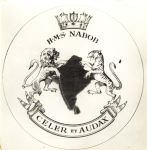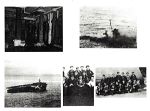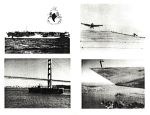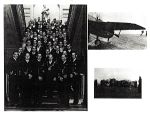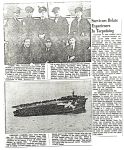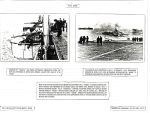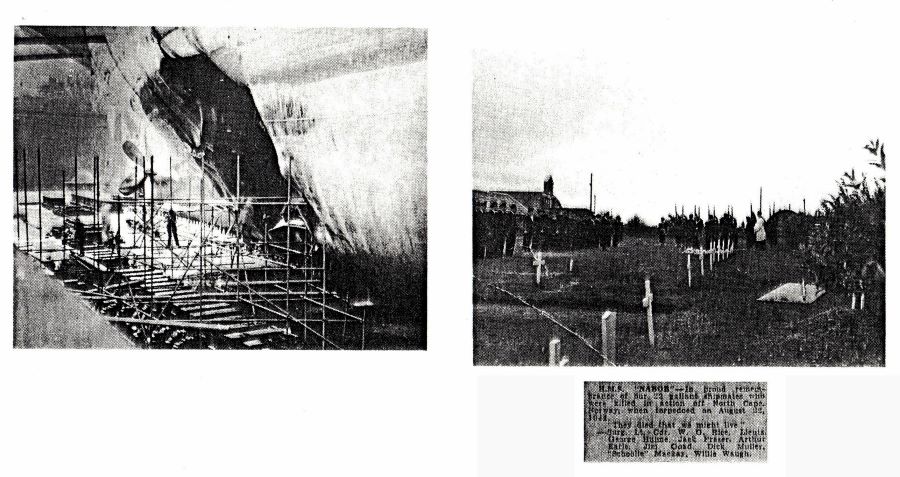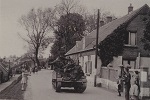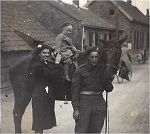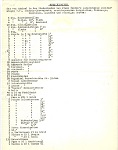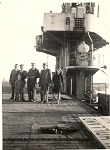|
HMS NABOB
Ruler Class Escort Aircraft Carrier
Laid down as the merchant vessel Edisto, but converted to an aircraft carrier while building, she was commissioned HMS NABOB at Tacoma, Wash., on 07 Sep 1943. After working up, she entered Burrard Drydock at Vancouver on 01 Nov for modification to RN standards, completing 12 Jan 1944. About this time it was arranged that she and a near-sister Puncher, should be manned largely by Canadians while remaining RN ships.
After training the ship went to San Diego and took the 852 FAA-Squadron on board, equipped with Avenger aircraft. She then proceeded with HMCS New Waterford via Panama Canal to Norfolk, where 45 P-51 Mustang fighters were embarked as deck load and U.S. Army Air Force personnel was taken on board as passengers when the ship made passage to UK in convoy VT-10. In April 1944, four Wildcat Mk.V fighters were added to the 852 FAA-Squadron, while a detachment of the 856 FAA-Squadron, equipped with Avenger Mk.II aircraft joined the escort carrier in June. NABOB joined the Home Fleet at Scapa Flow on 01 Aug 1944 and took part in two Operations that month off the coast of Norway. The first operation was Operation Offspring, a mine laying operation off Norway; the 2nd was an attack on the German battleship Tirpitz.
Photos and Documents Ship's company photos The Ship's Bell
HMS NABOB - Royal Navy Research Archive HMS NABOB photo gallery - Royal Navy Research Archive
REMEMBERING CHARLIE - From the memoirs of Lt Donald Bowman, RCNVR
Charlie and I literally bumped into each other on a street corner in Saskatoon about a year after war’s end. I met Charlie in basic training at Cornwallis in Nova Scotia. He was tall, athletic, blonde and friendly. When I looked at him on the street corner, I wasn’t certain it was Charlie. The confident Charlie was gone. The new Charlie was haggard and untidy. It was nearly noon and I invited him home for lunch. Muriel always gracious, welcomed Charlie and adroitly adjusted the menu. When coffee arrived, Charlie’s hands shook so much he required both hands to raise the cup to his lips. Gradually I coaxed him to tell us what happened to him.
After Cornwallis, Charlie joined HMS NABOB, a baby flat-top aircraft carrier. Off the coast of Norway, the ship took a torpedo. Charlie was ejected from his bunk. When he picked himself up from the deck, water was up his ankles. Charlie was first on the ladder and three friends were following. As Charlie emerged through the hatch, the command ‘close all white watertight doors and hatches’ boomed from the loudspeakers. A seamen stationed at that point slammed down the cover and tightened the turnbuckles. Charlie’s screams of protest were ignored and he was physically restrained from opening the cover.
NABOB was severely damaged, but kept afloat. It took 10 days to be towed to harbour. There were about 30 fatalities, mostly caused by drowning. It was a navy version of death by friendly fire. Militarily, the captain acted wisely. The rating who closed the hatch acted properly, instantly obeying an order. The captain was probably commended for saving the ship. Every 11 November, I remember Charlie and I eventually fall asleep, watching him and his three buddies endlessly climb the ladder and especially, the sailor who closed the hatch.
Webmaster's note: Charlie's last name is not known, nor are the names of his 3 friends - but those 3 friends are listed below with the 21 ratings who died that day.
The history of the Nabob - Post Second World War - Escort Carrier to Merchantman
Written by, H.L. van der Linden, The Netherlands
Submitted by H.L. van der Linden for posterity's sake
Background
on H.L. van der Linden and his research: I was the operational
managing director of the scrap processing plants of the Dutch steel Company,
Hoogovens (later on Corus and Tata Steel). One of the production
sites, operating under the name of Frank Rijsdijk-Holland, was specialized
in ship recycling (ship breaking). In 2002 I received a message from a
former German merchant captain, Mr. Gerhard Dannemann, who served as
boatswain on the ship TS Nabob. He asked me information about this ship,
especially in the period 1945-1950. I searched our old archives, talked with
former staff, visited libraries and gathered all information about this
vessel. I had some vague memories of the vessel. My father, who passed away
in 1986, was manager of the ship breaking yard and he showed me this huge
vessel (Nabob) in 1947. I have discovered during my research that
among older residents of the Rotterdam region, that the name Nabob has still
a special meaning. A miracle ship. At the time, I published my research in a
local newspaper. The ship breaking activities in the village Hendrik
IdoAmbachthave ended last year and this reminded me of the Nabob story. I wondered if there might be anyone in Canada still interested in this
story.
The naval history of the Nabob is extensively described in Mrs. Warrilow's book. In the epilogue is mentioned that the Nabob was sold in 1947 to a Dutch scrap yard and that the ship was resold in 1950 to Roland LinieSchiffart. (Nabob the first Canadian-Manned Aircraft Carrier. Published in Canada by Escort Carriers Assoc, Owen Sound Ontario ISBN 0-9693438-0-9)
The German part of the Nabob story is described in Dannemann's book. (Satz Verlag, Norderstedt Germany ISBN 978-3-8391-5618-6 8)
The history of the U-boat that torpedoed the Nabob as well as the fate of the German cruiser Tirpitz in Norway, the target of the operation Goodwood, is also documented . (Target Tirpitz, Bishop 2012 Harper Press ISBN 978-0-00-731924-4)
But what happened between 1947 and 1950? That is the subject of my part of the story.
The Canadian Army liberated the Netherlands from the Germans in 1945. My year of birth is 1941. I was photographed with a Canadian soldier "on a horseback" I wondered seeing this picture later on, that the cavalry played still a role in 1945. But the reason was very practical. The Netherlands had been completely robbed by the Germans in the 5 years of the occupation. Dannemann used the word Ausgeplundert (totally robbed) in his book. A horse, probably from Belgium, turned out to be very useful in that period . . . no shortage of grass.
In the Netherlands in 1945, we had nothing at all - not even basic tools or building material. All tools, bolts and nuts were accounted for by the Germans . . .to be paid for after the victory of the Nazi regime!
After the war the USA offered the obsolete and damaged equipment as scrap. The Nabob, laying in the First of Forth and no longer fit for service, also appeared in the bid-book. The scrap processing capacity of the Scottish yards was by far not sufficient to handle this quantity. The bid prices were supposed to be not too high. For the Dutch ship breakers, their main concern was how to get enough foreign currency. The value of the Dutch guilder was not much more than nothing. But anyway the Dutch made their estimates, the bid was submitted and…. accepted. The vessel to be paid at delivery!
Suddenly there came of stroke of luck. An American sales officer asked the manager of Holland ship breaking company, who had travelled with his team to Scotland, to prepare the transport for one carrier that was sold to a Scottish company. No blinking eyes at that moment by the buyers. And now the Dutch had enough money to fulfill their bid obligations and the Nabob could be towed to Rotterdam.
South of Rotterdam the ship runs on a sandbank in front of the yard, just like on the first trial in Vancouver. After a high tide of the Rhine in the autumn of the year, the ship could finally to be moored.
And so a practically new, hardly used ship, arrived in the Netherlands with all equipment, machinery, tools etc., that the Dutch have not seen in the last 3 years. It had been never the intention to dismantle the vessel and to convert it to pieces ready for charging the steel furnace. This ship was only 4 years old and could be convert again to a merchant vessel. The ship was stripped inventory which was then sold but the ship itself remained intact. The flight deck was also removed.
The Dutch merchant fleet had been decimated during the war. There should be an shipyard or ship owner interested in carrying out this job they thought. However that didn't work out as expected. Perhaps the asking price was too high, or the torpedo damage was too great a risk.
Then in 1949 a German shipping company shows up. Western Germany (BRD) would like to make a restart. Their merchant fleet had almost disappeared and besides, ships of owners who served before 1945 were seized in foreign ports to claim compensation for war damage. The new shipping company was looking for new vessels to avoid these matters.
Sell to Germans? Never, was the first reaction from the Dutch. But as time goes by there was a growing awareness that even an unused ship needs maintenance and by waiting the condition of the ship and installations will not improve.
After thorough negotiations the sale conditions were agreed upon. One of the conditions was the ship would keep the name Nabob. Specific installations such as the ventilation system of the hangar was dismantled and removed. This system served many years in a test centre for aircraft models in the Netherlands.
The Nabob was taken to a German shipyard in Bremen and converted into a modern cargo ship. It was the first German ship for new merchant crews after 1945. The first trip was to Canada to pick up grain for the starving German population. The Canadians offered the Germans grain, free of charge, but the Germans had to come and get it.
The Nabob sailed until 1977 and she was scrapped in Taiwan after almost 35 years.
Click here to view a few photo associated with Henk van der Linden's hitory of the Nabob
Commanding Officers
Capt Horatio Nelson Lay, OBE, RCN - 15 Oct 1943 - 30 Sep 1944
They shall not be forgotten
(s) - Survived the torpedoing of HMS NABOB
Former Crew Members
(s) - Survived the torpedoing of HMS NABOB
Photos and Documents
(NAB001) HMS NABOB in New York- RCN photo (NAB002) HMS NABOB (NAB003) HMS NABOB after being torpedoed - RCN photo (NAB004) HMS NABOB jacket patch // From the collection of Harold (Hal) Stevens, CPO1 Boatswain, RCN // Courtesy of Rob Stevens
(NAB005) Capt Horatio Lay inspects the shoring to the bulkheads after HMS NABOB was torpedoed // Click here to view the back of the photo // From the collection of Lorne Roy Shouldice // Courtesy of Jeff Shouldice (NAB006) 39 members of NABOB'S crew received medals for service during the invasion of Normandy // Hamilton Spectator 15 Jan 1945 // Courtesy of Mary Kienapple (Werbmaster's note: while the article lists NABOB 39 sailors who received awards, it is likely that not all listed served in NABOB - Kenneth Balch being one of those who did not serve in her.) (NAB007) Nicholas Boychuk on HMS NABOB // From the collection of Nicholas (Boychuk) Brock, Sto 1c, RCNVR // Courtesy of Rob Boychuk (NAB008) R-L: Paym-Lt Alan Collins, Capt. Horatio Lay and two unknown ratings on HMS NABOB
(NAB009-NAB011) HMS NABOB (NAB012) HMS NABOB in drydock. The damaga from the torpedo can be seen on the starboard side
Buried with full Naval Honours Funeral service for the twenty one members of the crew of the NABOB who lost their lives when their ship was torpedoed (NAB006) The firing party from HMS COCHRANE arriving at Douglas Bank Cemetery at Rosyth Photos NAB006, 008 and 010 - Source: IWM Admiralty Official Collection Photos NAB007 & NAB 009 from the collection of John C. Jones / Courtesy of Bruce Jones
(JJ01) HMS NABOB - RN photo (JJ02) HMS NABOB (JJ03) Aircraft taking off from HMS NABOB - Firth of Forth railway bridge and unknown escort carrier in background (JJ04) Newspaper article on the torpedoing of HMS NABOB (JJ05) Poem - Ode to NABOB From the collection of John C. Jones Courtesy of Bruce Jones
(RLW001) HMS NABOB, down by the stern after being torpedoed, with HMS TRUMPETER in the background (RLW002) HMS NABOB, down by the stern after being torpedoed (RLW003) HMS NABOB listing to starboard. Hose can be seen over the flight deck - for pumping water out of the ship (RLW004) Damage to HMS NABOB'S hull for the torpedo hit.
(NL01) HMS NABOB (NL02) Aircraft landing of HMS NABOB (NL03) Aircraft taking off from HMS NABOB - RMS Queen Mary below aircraft (NL04) Diesel Department crew of HMCS NABOB, Rosyth, Scotoand 21 Sep 1944 // LAC PA-140986 // Front row L-R: unknown, George Meredith, Leonard Love, unknown
(NL05) HMS NABOB, down by the stern after being hit by a torpedo from U-354. Note the crew all on the port side of the flight deck to help with the ship's trim (NL06) Frigate HMS BICKERTON - struck by a GNAT torpedo from U-354 that was meant to finish off HMS NABOB. After her crew was removed, HMS BICKERTON was sunk by a torpedo from HMS Vigilant (NL07) Crew of NABOB on the flight deck after the ship was torpedoed. HMS KEMPTHORNE astern of HMS NABOB (NL08-NL09) Crew of NABOB on the flight deck after the ship was torpedoed
(NL10) Crew of NABOB on the flight deck after the ship was torpedoed (NL11) Hoses pumping out water from flooded spaces (NL12) Officers on the bridge of NABOB (NL13) Life rafts and floats on the flight deck of HMS NABOB. HMS TRUMPETER astern of HMS NABOB (NL14) HMCS Algonquin alongside HMS NABOB
(NL15-NL16) Back at Scapa Flow, Capt Horatio Lay, CO, addresses the crew ((NL17) Crew of HMS NABOB formed up on the flight deck - possible a service for those lost (NL18) Newspaper article on the torpedoing of HMS NABOB (NL19) Leonard Love, George Meredith and others carrying one of their shipmates who was killed when HMS NABOB was torpedoed
(NL20) Merchant Vessel NABOB - former HMS NABOB (NL21) Newspaper article on the visit of the merchant vessel NABOB to Vancouver, BC, summer 1962
22 Aug 1944 - 50 Years later (NL22) Newspaper article on the 50th Anniversary of the torpedoing of HMS NABOB - 1994 (NL23) Souvenir of the crew reunion on the 50th Anniversary of the torpedoing of HMS NABOB (NL24) Reunion group photo (NL25-NL26) Letters from BC Premier Bill Van Der Zalm to Leonard Love and the attendees of the NABOB reunion
22 Aug 1944 - 60 Years later (NL27-NL28) Newspaper articles on the 60th Anniversary of the torpedoing of HMS NABOB - 2004
(NL29) Flyer from the RCNA on a book about HMS NABOB From the collection of Leonard Love, RCNVR Courtesy of Nicky Love
(NV03) HMS NABOB at anchor (NV04) HMS NABOB'S badge (NV05-NV06) Various photos of NABOB and her crew - before and after she had been torpedoed
(NV08-NV12) Articles on HMS NABOB
(NV13) (left) HMS NABOB in drydock after being torpedoed (right) Burial service for casualties of HMS NABOB - In proud remembrance of our 21 gallant shipmates who were killed in action off North Cape, Norway, when torpedoed on August 22, 1944. "They died that we might live." (signed) Surg. Lt-Cdr W. O. Rice, Lieuts George Hulme, Jack Fraser, Arthur Earle, Jim Coad, Dick Muller, "Schoolie" Mackay, Willie Waugh From the collection of Norman Veino, RCNVR Courtesy of Jonathan Richter
Photos submitted by Hank van der Linden associated with his post wartime history of the Nabob
(HL01) Canadian soldiers in Holland after liberation (HL02) Henk v. d. Linden on a horse that is being held by a Canadian soldier (HL03) An itemized list of material taken by the Germans to be paid for after the Nazi victory (HL04) Henk v. d. Linden on the deck of the Nabob at the breaker's yard in Holland (HL06) Article dated 31 Dec 1947 on the Nabob
(HL06) The former HMS NABOB after being stripped in preparation for conversion to a merchantman.
(HL07) Article by H.L. van der Linden in a local Dutch newspaper on the Nabob Click on the above article to view a larger image
|

